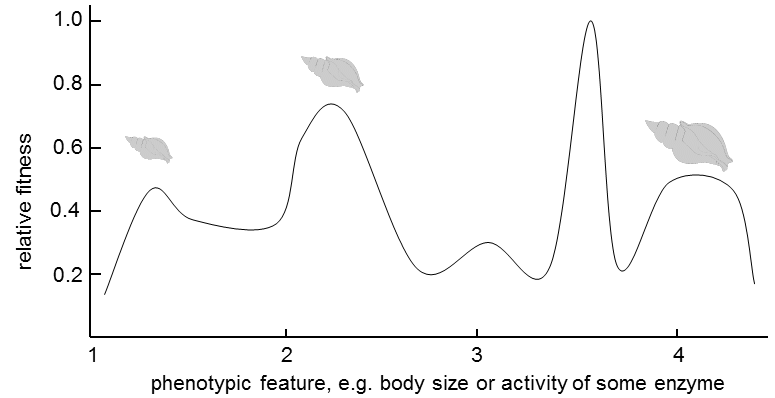I.13 Evolution does not optimize, but improves, it comes up with only local, not global, optima.
The fact that each new variant, each mutation that is to be fixed by natural selection, must be at least slightly better than the old variant, has important biological consequences and thus it should be examined more closely. Biologists study a great many evolutionary processes on the models of an adaptive landscape.The American biologist Sewall Wright introduced the model of the adaptive landscape into evolutionary biology at the beginning of the nineteen thirties. In actual fact, this consists of two quite different models, between which not even their author always sufficiently differentiated (Edwards 1994). This is an abstract model of either the environment and the individual organisms or the environment and populations. In the former case, the evolution of organisms in the environment can be conceived, e.g., as a three-dimensional topographical map, in which the x and y coordinates correspond to two qualities of a hypothetical organism (e.g. body weight and maximum speed of movement); in the second case, the frequency of the alleles are on the x and y axes at two different loci and the average biological fitness of the given population is on the z axis. Let us now return to the first model of an adaptive landscape. The shape of the surface of an adaptive landscape, the system of hills and valleys, is given independently of the properties of the organisms and determines the distribution of future niches in the particular environment. The projection of the points onto the surface of the adaptive landscape, i.e. coordinate z, determines the fitness of each individual organism (characterized in our model by properties X and Y). It is apparent that various combinations of X and Y are variously advantageous from the standpoint of natural selection. Mutations, i.e. a change in coordinate x or y, move the organism from one place to another, also shifting their projections onto the surface of the adaptive landscape. Only mutations that shift the projection of the organism uphill in the plane of the adaptive landscape, to places with larger coordinate z, can be fixed by natural selection. It is apparent that, under suitable circumstances, in time, organisms climb up to the peaks of the individual hills.
However, there is no rule stating that all the peaks should be occupied or that they should climb up to the highest peaks (Fig. I.15). If there is a valley between two peaks, the organisms are not capable of getting from one peak to another. If a mutant finds itself in an area with a lower “altitude”, it is either eliminated by natural selection, or its descendants climb, over time, (through further mutations) back up the closest peak. Thus, it can happen that, next to an occupied peak, an exploited niche, there exist several empty peaks, possibly even higher, onto which the organisms cannot climb.

Fig. I.15 The adaptive landscape. One of the possible variants is a one-dimensional landscape. The conditions of the environment and especially the distribution of niches determine the topology of the adaptive landscape, i.e. the number, shape, height and location of the individual peaks. As a consequence of mutations, the phenotype of the organism changes and thus the x-coordinate of its position in the adaptive landscape also changes. The corresponding y-coordinate and thus the biological fitness of an individual are determined by the topology of the landscape at the site of the relevant x-coordinate. Because of the inability to predict the future advantageousness of evolutionary changes and thus the inability to move, even temporarily, down the slope of the adaptive landscape into the valley, individual species of organisms are capable only of climbing up the slope during their evolution and can occupy only local maxima. Consequently, some peaks in the adaptive landscape, sometimes including global maxima, remain unoccupied for a long time or even permanently
This means that evolution does not optimize, for this it would need to overcome the valley in the adaptive landscape, evolution only improves. A practical consequence of the inability of evolution to overcome the valleys in an adaptive landscape could consist in the fact that, over the course of evolution, a vertebrate never developed that could fly using large, moveable ears. The wings of vertebrates always developed only at the expense of the front limbs. This undoubtedly high peak in the adaptive landscape, flying ears, has thus remained empty, as the intermediate stages between normal-sized ears and ears of a size that would be of practical importance for flying are selectively disadvantageous and any potential mutants are located well down in the valleys of the adaptive landscape.
